Article Information
- Chang Yuan, FuJun Niu, QiHao Yu, XinBin Wang, Lei Guo, YanHui You. 2015.
- Numerical analysis of applying special pavements to solve the frost heave diseases of high-speed railway roadbedsin seasonally frozen ground regions
- Sciences in Cold and Arid Regions, 7(4): 340-347
- http://dx.doi.org/10.3724/SP.J.1226.2015.00340
Article History
- Received: February 23, 2015
- Accepted: May 6, 2015
2. University of Chinese Academy of Sciences, Beijing 100049, China
1 Introduction
Frost heave is one of the main causes of roadbed diseases in the seasonally frozen ground area, which covers 53.5% of the total l and area in China(Xu, 2001; Chen et al., 2006). Mud pumping and frost boiling might occur in the highway roadbeds and freeze-thaw collapse might appear in the railway roadbeds. According to observational data from 2004 to 2005(Cheng, 2006), diseases of frost heave occurred in 16, 123 sections with a total length of 334.45 km in the scope of the Haerbin Railway Administration, in 1, 376 sections with a total length of 34.5 km in the scope of the Shenyang Railway Administration, and in 78 sections with 13.7 km in length in the scope of the Huhehaote Railway Administration.
The Haerbin-Dalian Passenger Dedicated Line(HDL)is the first high-speed railway designed and constructed in middle-deep seasonally frozen ground regions in China. It extends from Haerbin to Dalian, traversing three provinces in northeastern China with a total length of 903.9 km. In this region the freezing period is from about November to March, during which the surface layers of natural fields and roadbeds might be frozen but the other parts of the soil remain thawed all year. The roadbed of the railway is 231.245 km, 181.67 km of which is slab track without ballast; the railway subgrade has been generally damaged badly by frost heave diseases, which must be solved to ensure the safe operation of the railway.
The roadbeds of slab tracking along the HDL were constructed with A/B group fills, which is a type of level I non-frost-heave material with an average frost heave rate of below 1%(TB 10035, 2006). Based on related research(Liu et al., 2011), the seasonally frozen depth along the HDL ranges from 0.88 m to 2.9 m. According to the Code for Design on Special Subgrade of Railway(TB 10035, 2006), the permitted frost heave rate of A/B group fills is 1%; therefore, if the HDL material met this requirement, the permitted amount of frost heave would be 8.8-29 mm, which exceeds the deformation limit of 15 mm for high-speed railways(China Railway First Survey and Design Institute Group Ltd., 2007; Yu, 2013). Sheng et al.(2014)acquired deformation observational data in the cold season from 2012 to 2013, and found that the maximum frozen depth at Siping was 2.5 m and the frost heave amount was approximately 20 mm; at Kaiyuan, the seasonally frozen depth was 2.5 m and the frost heave amount was about 18 mm. The frost heave rates were less than 1%, suggesting that the group fills worked as required, but the actual amounts of frost heave were more than the deformation limit value.
Frost heave is mainly related to soil properties and frozen depth. Researchers experimentally replaced the roadbed fills with modified A/B group fills that had cement, which could reduce the maximum frozen depth by 20-30 cm and also reduce the frost heave(Liu et al., 2011). However, those fills could not provide improved thermal properties for the embankment. Insulation layers such as XPS and EPS might reduce the frozen depth to a certain extent by preventing heat release from the subgrade, given their low thermal conductivity, but this is a passive measure and the effects would become weaker year after year(Sheng et al., 2002).
This paper proposes to replace the currently used cement pavement with black pavement or insulation-black pavement to solve the frost heave diseases along the HDL subgrade. Using a finite element method with ANSYS, the roadbed temperature fields over the next 30 years were respectively simulated with the boundary conditions of cement pavement, black pavement and insulation-black pavement over the next 30 years. The freezing index of the roadbed surface, the seasonally frozen depth, the freezing period, and thawing area in the subgrade were analyzed contrastively, and it predicted their trends over the next 30 years.
2 Frost heave of subgrade along the HDL high-speed railwayFrost heave includes in-situ frost heave and segregated ice frost heave. In-situ frost heave occurs when the pore water in the freezing soil, or unfrozen water in the frozen soil, is frozen to ice in situ. The corresponding amount of frost heave is closely related to the frozen depth, that is, the amount of frost heave increases as the frozen depth increases. Segregated frost heave occurs when the moisture in the soil is driven by the temperature gradient to the freezing front and is frozen into segregated ice lenses. The corresponding amount of frost heave is closely related to the water content and supply in the soil, and the length of the freezing time. In other words, the amount of frost heave keeps increasing as the freezing time continues and enough water is supplied, but during this time the frozen depth stays almost constant.
Figure 1 shows that the amount of frost heave in different layers varied with the frozen depth at Siping. The curve "0.5" represents the amount of frost heave in the top 0.5-m layer, which was from the surface to the depth of −0.5 m in the subgrade. The curves "1.5" and "2.7" represent the amount of frost heave in the top 1.5 m and 2.7 m layers of the roadbed. The curve "0.5" kept rising up to 7.5 mm before the frozen depth rose to 0.5 m, and then it remained nearly constant; the curve "1.5" increased to 16 mm before the frozen depth increased to 1.5 m, then it stayed constant; the curve "2.7" rose to 19 mm when the frozen depth reached the maximum value of 2 m. In Figure 1, it appears that the curve "2.7" is below curves "0.5" and "1.5" in certain periods, which infers that soil consolidation might have occurred in the layer from 1.5 m to 2.7 m if there was no measurement error. The A/B group fills layer was from 0.5 m to 2.7 m, and its frost heave rate was approximately 0.7%, which was below 1%, suggesting the material used met the design requirement.
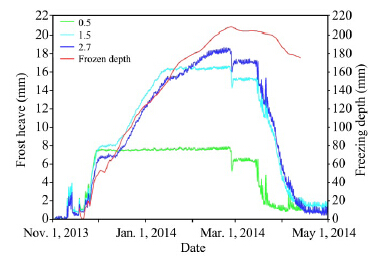 |
| Figure 1 Observational frost heave amount and frozen depth at Siping |
The trends of the three curves were mostly determined by frozen depth except for the material physical property such particle size and soil type. It could be predicted that:(1)the frost heave mainly consisted of in-situ frost heave, as was discussed above;(2)although the A/B group fills met the design requirements, the frost heave amount exceeded the frost heave limit amount of 15 mm.
3 Mechanism of black pavement and insulation-black pavement in improving roadbed thermal regimeIn the permafrost region of the Qinghai-Tibet Plateau, the heat balance of the original natural field has been disrupted by human activity, including road engineering. The asphalt pavement on the Qinghai-Tibet Highway has promoted thawing of the frozen soil under the subgrade by accumulating heat in the roadbed, because it absorbs more radiation than the natural field surface(Wu et al., 1988; Wu et al., 2001). In the seasonally frozen ground region of northeastern China, the seasonal freezing layer of the HDL roadbed might induce enough frost heave to affect the safe operation of the railway. In order to solve the frost heave problem, measures such as asphalt pavement could be applied to absorb more heat to reduce the seasonal freezing layer. Otherwise, it would take other measures to prevent heat release from the roadbed on the basis of asphalt pavement, which would resist freezing. One such measure would be insulation-black pavement to store more heat inside the roadbed.
3.1 Black pavementBlack pavement was proposed to replace the cement pavement used currently. This kind of dark pavement, such as asphalt pavement, can absorb more and reflect less solar radiation than cement pavement. The radiation absorptivity(A), radiation reflectivity(R), and radiation transparency(D)follow this equation:
| $A + R + D = 1$ | (1) |
| $A + R = 1$ | (2) |
In solar radiation, 46% is visible light, which is selectively absorbed by surfaces with different colors(Xu, 2001). The reflectivity R of cement pavement is approximately 0.48, and the radiation absorptivity of black pavement is about 0.80-0.95, which is much greater than that of cement pavement(Liang, 2006; Wang et al., 2008). Thus, black or asphalt pavement would absorb much more heat than cement pavement, which might solve the frost heave disease of subgrade to a certain degree.
3.2 Insulation-black pavementAs mentioned, black pavement could absorb more heat into the roadbed. If measures are added that allow sunlight through but prevent the heat from dissipating, even more heat would remain in the subgrade. For example, aerogel is transparent and its thermal conductivity is low, to 0.018 W/(m∙K), and there are other foam materials that have similar properties.
Insulation-black pavement consists of black pavement with a thin layer of insulation material glued onto the pavement surface; the latter material is originally set as an aerogel. Insulation-black pavement could not only absorb more heat by receiving solar radiation like black pavement, but also keep more heat in the subgrade by preventing its release. Compared with black pavement, insulation-black pavement is better able to prevent frost heave of roadbeds.
4 Numerical simulations 4.1 Physical modelsThe Changchun experimental section(D3K692+840 to D3K692+860)was selected as the simulation background. Figure 2 shows a section view of the roadbed with ballastless track plate. The width of the roadbed is 13.6 m, the height is 3.5 m, and the slope gradient is 1:1.5. From top to bottom, the first layer of the roadbed is a gravel layer 0.7 m thick, the second is A/B group fills 2.3 m thick, and the bottom layer is a crushed stone and s and layer 0.5 m thick, which is composed of three layers of crushed stone interlaid by two layers of s and , where each layer is 10 cm thick. Two slayers of compound geomembranes were laid at −0.7 m and −3.0 m in the subgrade. The foundation soil is yellow clay reinforced by 20-m-long cement-fly ash-gravel(CFG)piles. The calculated domain of the natural field is extended 30 m from the slope toe in the horizontal direction and 10 m from the natural surface in the vertical direction.
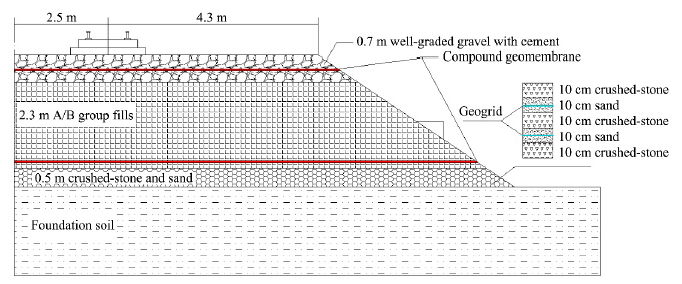 |
| Figure 2 Profile of the HDL high-speed railway roadbed |
Based on the design of the HDL roadbed, a two-dimensional model was built considering heat conduction and phase change and ignoring heat convection, moisture migration, and certain other factors. Unfrozen water content was assumed as a function of temperature, and the model could be described as follows:
In the unfrozen zone:
| ${\rho _u}{c_u}\frac{{\partial {T_u}}}{{\partial t}} = \frac{\partial }{{\partial x}}({\lambda _u}\frac{{\partial {T_u}}}{{\partial x}}) + \frac{\partial }{{\partial y}}({\lambda _u}\frac{{\partial {T_u}}}{{\partial y}})$ | (3) |
In the frozen zone:
| ${\rho _f}{c_f}\frac{{\partial {T_f}}}{{\partial t}} = \frac{\partial }{{\partial x}}({\lambda _f}\frac{{\partial {T_f}}}{{\partial x}}) + \frac{\partial }{{\partial y}}({\lambda _f}\frac{{\partial {T_f}}}{{\partial y}})$ | (4) |
In Equations (3) and (4), the subscripts u and f represent unfrozen and frozen phases, and ρ, T, c and λ are respectively soil density(kg/m3), temperature(°C), specific heat(J/(kg∙°C)), and thermal conductivity(J/(m∙h∙k)).
The freeze-thaw interface meets the continuous condition and conservation of energy:
| ${T_f}(\xi (t),t) = {T_u}(\xi (t),t) = {T_m}$ | (5) |
| ${\lambda _f}\frac{{\partial {T_f}}}{{\partial n}} - {\lambda _u}\frac{{\partial {T_u}}}{{\partial n}} = L{\rho _d}(\omega - {\omega _u})\frac{{{\rm{d}}\xi (t)}}{{{\rm{d}}t}}$ | (6) |
The equivalent specific heat was adopted in the calculation, the phase change was assumed to occur in the temperature range(Tm±ΔT), and the parameters cf, cu, λf and λu were set as constant. The equivalent specific heat was defined as follows(Bonacina et al.,1973):
| $C = \left\{ \begin{array}{l} {C_u}(T > {T_p})\\ {C_f}{\rm{ + }}\frac{{{C_u} - {C_f}}}{{{T_p} - {T_b}}}(T - {T_b})\\ + \frac{L}{{(1 + W)}}\frac{{\partial {W_i}}}{{\partial T}}\left( {{T_b} \le T \le {T_p}} \right)\\ {C_f}(T < {T_b}) \end{array} \right.$ | (7) |
| $\lambda = \left\{ \begin{array}{l} {\lambda _u}\left( {T > {T_p}} \right)\\ {\lambda _f} + \frac{{{\lambda _u} - {\lambda _f}}}{{{T_p} - {T_b}}}(T - {T_b})\left( {{T_b} \le T \le {T_p}} \right)\\ {\lambda _f}\left( {T < {T_b}} \right) \end{array} \right.$ | (8) |
In Equations (7) and (8), C is the equivalent specific heat, J/(kg∙°C); Cf and Cu are respectively the specific heat of frozen soil and unfrozen soil, W and Wi are respectively the total water content and ice content in the frozen soil, %; and Tp and Tb are respectively the top boundary temperature and bottom boundary temperature of the intensive phase change, °C.
The unfrozen water content could be calculated out as follows(Xu et al., 1985):
| ${W_u} = a{\theta ^{ - b}}$ | (9) |
| $b = \frac{{\ln {W_{\rm{0}}} - \ln {W_u}}}{{\ln \theta - \ln {\theta _f}}}$ | (10) |
| $a = {W_{\rm{0}}}\theta _f^b$ | (11) |
Combining Equations (7) and (8), Equations (3), (4), (5), and (6) could be simplified as:
| $\rho C\frac{{\partial T}}{{\partial t}} = \frac{\partial }{{\partial x}}(\lambda \frac{{\partial T}}{{\partial x}}) + \frac{\partial }{{\partial y}}(\lambda \frac{{\partial T}}{{\partial y}})$ | (12) |
The problem of the roadbed temperature field in seasonal frozen ground refers to the transient temperature field concerning phase change, and the position of the freeze-thaw interface varies with time. Therefore, the condition of energy conservation at the freezing front is nonlinear, and this problem belongs to a strongly nonlinear problem that does not have a typical analytical solution. Therefore, the Calerkin numerical analytical method is used and the finite element calculation formulae are presented as follows(Lai et al., 2004):
| $[M]\{ \frac{{\partial T}}{{\partial t}}\} + [K]\{ T\} = \{ F\} $ | (13) |
In Equation (13), [M] is an unstable matrix of temperature variation, [K] is a stiffness matrix of temperature, {T} is a column vector of known temperatures, and {F} is the load column vector of temperature corresponding to the boundary conditions. These matrixes could be calculated as the following equations:
| ${M_{ij}} = \sum {\int_{{\Omega ^e}} {C{N_i}{N_j}{\rm{d}}\Omega } } $ | (14) |
| $\begin{array}{l} {K_{ij}} = \sum {\int_{{\Omega ^e}} {\lambda (\frac{{\partial {N_i}}}{{\partial x}}\frac{{\partial {N_j}}}{{\partial x}} + \frac{{\partial {N_i}}}{{\partial y}}\frac{{\partial {N_j}}}{{\partial y}})} } {\rm{d}}\Omega \\ + \sum {\int_{\Gamma _2^e} {\alpha {N_i}{N_j}{\rm{d}}\Gamma } } \end{array}$ | (15) |
| ${F_i} = \sum {\int_{\Gamma _2^e} {\alpha {T_a}{N_i}{\rm{d}}\Gamma } } $ | (16) |
Herein, Ni and Nj are shape functions, Ω is the integral domain of the temperature field, α is a coefficient of heat convection, and Γ represents the integral boundary of the thermal domain.
4.3 Boundary and initial conditionsBased on the local weather observational data and the adherent layer theory(Zhu, 1988), the upper temperature boundaries were set as follows:
| $T = {T_0} + \frac{{\Delta T}}{{8760}}t + A\sin (\frac{{2{\rm{\pi }}t}}{{8760}} + \varphi ) \\ {T_0} = {T_\alpha } + \Delta {T_f}$ | (17) |
In this equation, Tα represents the mean annual air temperature, which was set at 5.3 °C according to the temperature data measured by the local meteorological station in 2012; T0 represents the mean annual temperature of the surface layer; and ΔFf is a temperature increment for the adherent layer, whose value could be set in the range of 2.5-6.5 °C for different surface conditions(2.5 °C for natural field, 3.5 °C for the roadbed surface with cement pavement and its slope, and 6.5 °C for black pavement)(Zhu, 1988). When considering the effect of global warming, ΔT is introduced as 0.04 °C/a(Wei et al., 2008); A is the temperature amplitude, which was set at 19.9 °C for the natural field and 21.9 °C for the roadbed surface(Liu et al., 2012), besides, 18.5 °C for the insulation-asphalt surface in the cold season. t is the time since the engineering was completed, whose unit is hour; and φ is the initial phase position in the calculation, set at π/2(corresponding to the warmest time in a year, July 10), meaning the roadbed was completed on July 10.
The side boundaries were set as heat insulation, that is:
| $\frac{{\partial T}}{{\partial n}} = 0$ | (18) |
The bottom boundary condition could be set as a constant based on the measured data(Liu et al., 2012):
| $T = {T_{{\rm{depth}} = - 10}} = 9\;{\rm{^\circ C}}$ | (19) |
The initial condition could be set the natural field temperature regime calculated for 30 years, with ΔT=0 °C being the upper boundary, and the roadbed initial temperature is set the highest temperature in a year, 27.7 °C.
4.4 Physical properties of soilsThe roadbed was constructed with three soil layers, and the physical properties of each layer are displayed in Table 1(Liu et al., 2012).
| Material | Position(m) | Density(kg/m3) | Water content(%) | Thermal conductivity(J/(m∙h∙k)) | Specific heat(J/(kg∙K)) | ||||||
| Frozen | Unfrozen | Frozen | Unfrozen | ||||||||
| Gravel | 2.8-3.5 | 1, 780 | 10 | 6, 948 | 6, 456 | 2, 107 | 2, 785 | ||||
| A/B group fills | 0.5-2.8 | 2, 060 | 6 | 5, 040 | 4, 140 | 706.6 | 861.7 | ||||
| Crushed stone | 0.0-0.5 | 1, 800 | 7 | 4, 789 | 3, 988 | 1, 731 | 2, 033 | ||||
| Clay loess | −10.0-0.0 | 1, 540 | 5 | 5, 688 | 4, 057 | 1, 158 | 1, 466 | ||||
In order to compare the effects, the simulated results of roadbed temperature fields with different pavements were analyzed contrastively.
Because the frost heave at Siping is primarily in-situ frost heave, the amount of frost heave is mainly determined by the seasonal freezing depth, which could be influenced by the freezing index at the surface(Xu, 2001). The freezing index is the integral of the freezing temperature and the freezing time. Figure 3 shows the temperature curves at the center of the roadbed surface in the cold season from October to April of the next year. The freezing index at the roadbed surface of cement pavement was 1, 100 °C∙d, it was 694 °C∙d at the roadbed surface of black pavement, and it was 396 °C∙d at the roadbed surface of insulation-black pavement. When the cement pavement was replaced with black pavement, the freezing index of the roadbed surface was reduced by 37%, and when the cement pavement was replaced with insulation-black pavement, the freezing index was reduced by 64%. It could thus be inferred that the seasonal freezing depth would be decreased by replacing the cement pavement with black pavement or insulation-black pavement.
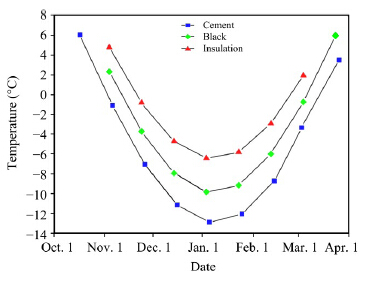 |
| Figure 3 Temperature curve at the center of the roadbed surface in the fifth year after roadbed completion |
Figure 4 shows the isothermal lines of temperature fields at the roadbed center. Under the condition of cement pavement(Figure 4a), it started to freeze in early November and ended in mid-March of the next year. The freezing period lasted for five months, and the maximum frozen depth was approximately 1.7-1.8 m. According to the Code for Design Special Subgrade for Railway, the permitted frost heave rate is 1%. Considering safety, the designed amount of frost heave was 17-18 mm, which exceeded the deformation limit of 15 mm. Under the black pavement(Figure 4b), the freezing period extended from mid-November to early March, lasting for about four months. The seasonal freezing depth was 1.3-1.4 m and the corresponding designed frost heave amount was 13-14 mm, which was under the deformation limit value. For insulation-black pavement(Figure 4c), the roadbed was frozen from late January until late February, and its freezing period was about two months. The seasonal freezing depth was approximately 1 m and the designed amount of frost heave was 10 mm, which also met the required deformation limit.
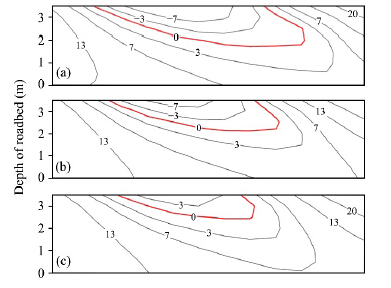 |
| Figure 4 Isothermal lines within the subgrade at the roadbed center in the fifth year after the roadbed completion.(a)cement pavement;(b)black pavement;(c)insulation-black pavement |
Compared with cement pavement, black pavement could reduce the freezing period by approximately 19 days and the maximum frozen depth would be decreased by 0.4 m. Consequently, the frost heave would be reduced by 4 mm, a reduction of 23%. By replacing cement pavement with insulation-black pavement, the freezing period could be reduced by about 40 days and the seasonal freezing depth would be decreased by 0.7-0.8 m. The frost heave would be reduced by 7-8 mm, a reduction of 40%-50%. Thus, the application of black pavement or insulation-black pavement could have a significant effect on reducing frost heave, especially the insulation-black pavement. More detailed comparisons are displayed in Table 2.
| Pavement | Initial freezing time | Freezing end time | Freezing period | Seasonal freezing depth | |||||||
| Date | ∆Date | Date | ∆Date | T | ∆T | Depth | ∆Depth | ||||
| Cement | Nov. 3 | Mar. 16 | 4 months, 13 days | 1.7-1.8 m | |||||||
| Black | Nov. 12 | 9 days | Mar. 6 | 10 days | 3 months, 24 days | 19 days | 1.3-1.4 m | 0.4 m | |||
| Insulation-black | Nov. 21 | 18 days | Feb. 24 | 22 days | 3 months, 3 days | 40 days | 1.0 m | 0.7-0.8 m | |||
Figure 5 shows the trends of seasonal freezing depth under the three pavements. All three of the curves decrease slightly, which might be caused by "heat accumulation" in the subgrade and global warming. The seasonal freezing depths under the black pavement and the insulation-black pavement are predicted to remain 0.4 m and 0.7-0.8 m shallower than the cement pavement over the next 30 years.
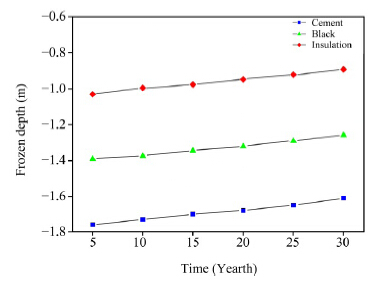 |
| Figure 5 Maximum frozen depth in the next 30 years at the roadbed center |
Figure 6 shows the temperature field under the three pavements on March 4, when the maximum frozen depth of the roadbed with cement pavement occurred. Comparing the three figures, the thawed area in the three subgrades could be ranked: insulation-black pavement > black pavement > cement pavement. The roadbeds with black pavement and insulation-black pavement were warmer than with the cement pavement, and the seasonal freezing depths under the two special pavements were less than under the cement pavement.
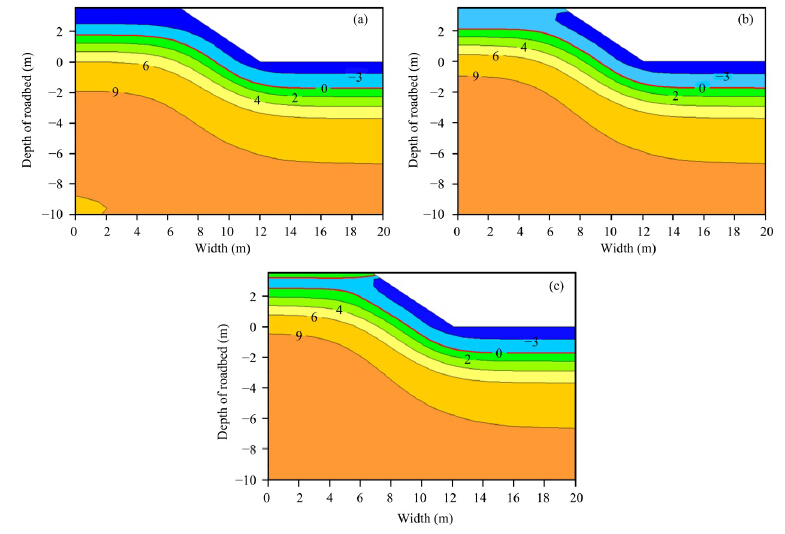 |
| Figure 6 Isothermal lines of the roadbed on March 10 in the fifth year after completion.(a)cement pavement;(b)black pavement;(c)insulation-black pavement |
To sum up, the two special pavements could reduce the seasonal freezing depth, shorten the freezing period, and better warm the roadbed. Therefore, the two special pavements could not only solve the frost heave disease, but also provide better thermal stability for subgrades.
6 Conclusions1)Based on the measured data of frost heave and frozen depth, the amount of frost heave was determined by the frozen depth.
2)The simulation results showed that by replacing cement pavement with black pavement or insulation-black pavement, the seasonal freezing depth could be respectively reduced by 0.4 m or 0.7-0.8 m, and the corresponding designed amount of frost heave could be respectively decreased by 4 mm or 7-8 mm, reductions of 23% or 40%-50%.
3)By applying black pavement or insulation-black pavement, the freezing period of the roadbed would be respectively reduced by 19 days or 40 days, and the subgrades would get and remain warmer than under cement pavement.
4)Generally, the application of these two special pavements could not only solve the frost heave disease, but also provide better thermal stability for roadbeds.
Acknowledgments: The authors would like to thank the anonymous reviewers for their critical reviews and comments on drafts of this manuscript. This research was supported by the National Science and Technology Support Program(No. 2014BAG05B03); the National Key Basic Research Program of China(973 Program)(No. 2012CB026106), and the Program for Innovative Research Group of the Natural Science Foundation of China(No. 41121061).| Bonacina C, Comini G, Fasano A, et al., 1973. Numerical solution of phase-change problems. International Journal of Heat and Mass Transfer, 16(10): 1825-1832.DOI:10.1016/0017-9310(73)90202-0. |
| Chen XB, Liu JK, Liu HX, et al., 2006.Frost Action of Soil and Foundation Engineering. Beijing: Science Press, pp. 3-17. |
| Cheng AJ, 2006. Study on the Filling Heave Classification of Railway Subgrade. Beijing: China Academy of Railway Sciences. |
| China Railway First Survey and Design Institute Group Ltd., 2007. Engineering Geological Investigation Report of Foundation Treatment and Protection of Embankment Slope in Haerbin-Dalian Passenger Special Line (D3K690+700-D3K693+000). Xi'an: China Railway First Survey and Design Institute Group Ltd.. |
| Lai YM, Wang QS, Niu FJ, et al., 2004.Three-dimensional nonlinear analysis for temperature characteristics of ventilated embankment in permafrost regions. Cold Regions Science and Technology, 38(2-3): 165-184.DOI:10.1016/j.coldregions.2003.10.006. |
| Liang MJ, 2006. Asphalt pavement light thermal reaction mechanism and heat-reflection coating engineering research. Master thesis ofHaerbin Institute of Technology, U416.217. |
| Liu H, Niu FJ, Niu YH, et al., 2011. Study of design of filling material and setting anti-frost layer for high-speed railway roadbed in seasonally frozen regions. Chinese Journal of Rock Mechanics and Engineering, 30(12): 2549-2557. |
| Liu H, Niu FJ, Niu YH, et al., 2012. Experimental and numerical investigation on temperature characteristics of high-speed railway's embankment in seasonal frozen regions. Cold Regions Science and Technology, 81: 55-64.DOI:10.1016/j.coldregions.2012.04.004. |
| Sheng DC, Zhao GT, Zhang S, et al., 2014. Possible frost heave mechanisms in an unsaturated high-speed railway formation. In: KhaliliN, RussellAR, KhoshghalbA (eds.). Sixth International Conference on Unsaturated Soils. Conference Proceedings, Unsaturated Soil: Research & Applications. London: CRC Press, 1: 3-14. |
| Sheng Y, Zhang LX, Yang CS, et al., 2002. Application of thermal-insulation treatment to roadway engineering in permafrost regions. Journal of Glaciology and Geocryology, 24(5): 618-622. |
| TB 10035, 2006. Code for Design on Special Subgrade of Railway. Beijing: China Railway Publishing House. |
| Wang DP, Fu Z, Fang JH, et al., 2008. Influence of solar radiation on surface thermal regime of different pavement types and its permafrost underlying embankment on the Qinghai-Tibetan Plateau. Journal of Highway and Transportation Research and Development, 25(3): 38-43. |
| Wei Z, Jin HJ, Luo CX, et al., 2008. Characteristics of atmospheric environmental changes of permafrost in northeastern China in 50 years. Journal of Lanzhou University (Natural Sciences), 44(3): 39-42. |
| Wu QB, Liu YZ, Zhu YL, 2001. Thermal state of active layer under asphalt pavement of Qinghai-Tibet Highway. Journal of Xi'an Highway University, 21(1): 23-25.DOI: 10.3321/j.issn:1671-8879.2001.01.006. |
| Wu ZW, Cheng GD, Zhu LN, et al., 1988. Roadbed Engineering in Permafrost Region. Lanzhou: Lanzhou University Press. |
| Xu XZ, Oliphant JL, Tice AR, 1985. Soil water potential, unfrozen water content and temperature. Journal of Glaciology and Geocryology, 7(1): 1-14. |
| Xu XZ, Wang JC, Zhang LX, 2001. Frozen Soil Physics Science. Beijing: Science Press, pp. 9-12. |
| Yu L, 2013. Observation and analysis on frost heaving deformation at subgrade of Haerbin-Dalian PDL. Subgrade Engineering, (3): 54-58, 63. |
| Zhu LN, 1988. Study of the adherent layer on different types of ground in permafrost regions on the Qinghai-Xizang Plateau. Journal of Glaciology and Geocryology, 10(1): 8-14. |
 2015, 7
2015, 7


